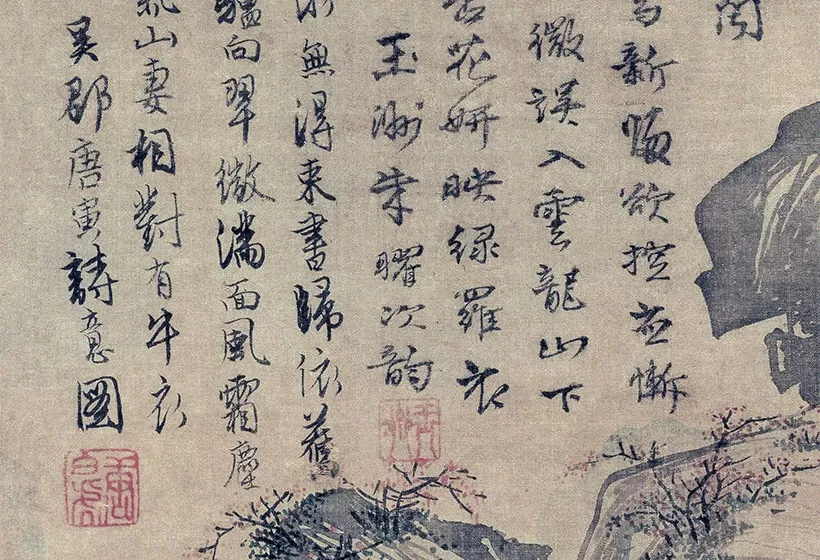Traditional Chinese Calligraphy
Calligraphy, as an art form involving the writing style of characters, includes Chinese, Mongolian, and Arabian handwriting, among which a Chinese calligraphy is a form of calligraphy widely practiced and revered in the Chinese cultural sphere. In a broad sense, calligraphy refers to a set of rules for writing characters. In other words, when practicing calligraphy, one should pay attention to the features and implications of the characters as well as their strokes and components so as to make them an art piece. Chinese calligraphy, as a unique performing art, is often regarded as sheer life experienced through energy in motion that is registered as traces on silk or paper, with time and rhythm in shifting space as its main ingredients. The ink brush, ink, paper, and inkstone are essential implements of Chinese calligraphy.
Ink Brush
The brush is the traditional writing implemented in Chinese calligraphy. The body of the brush can be made from either bamboo, or rarer materials such as red sandalwood, glass, ivory, silver, and gold. The head of the brush can be made from the hair (or feathers) of a wide variety of animals, including the weasel, rabbit, deer, chicken, duck, goat, pig, tiger, wolf, etc. The head of the brush made from the hair of a goat is soft, referred to as soft brush; while the head made from such animal hairs as rabbit and weasel is hard, referred to as hard brush. The head made of a mixture of soft and hard hairs is called a hybrid brush.
Ink
Ink enjoys a time-honored history. According to historical records, the earliest ink was invented in the Western Zhou Dynasty. The ink is made from lampblack (soot) and binders and comes in ink sticks which must be rubbed with water on an ink stone until the right consistency is achieved. Back in the Northern and Southern Dynasties, the ink produced in Yizhou was the most famous around China.
Paper
Paper is commonly regarded as one of the four great inventions of ancient China. Flax-made paper that is rough in texture has been unearthed in an ancient tomb of the Western Han Dynasty. Most of the existing paintings and calligraphic works since the Han Dynasty are found on mulberry paper. In the Eastern Han Dynasty, Cai Lun employed new materials and improved the techniques of making paper, and as a result, both the quality and production of the paper were greatly enhanced. As the paper was widely used, Emperor Jin’an decreed that the use of bamboo as a writing material should be banned. Consequently, the paper was widely accepted as the material for writing.
Ink Stone
The use of ink stone can be traced back to as early as the Western Han Dynasty. The earliest ink stone was unearthed in an ancient tomb of the Western Han Dynasty, Phoenix Mountain, Jinzhou, Hubei Province. In China, there are four types of most renowned ink stones, namely Duan, She, Tao and Chengni.
Styles
The styles refer to the fonts of the characters. Traditionally, there are altogether five types of styles, namely running script, cursive script, regular script, seal script, and clerical script. And there are some subcategories subordinate to each style. For instance, seal script can be divided into two types, namely large seal script and small seal script.
Couplets
Chinese couplets or "contrapuntal couplets" may be seen on doorways in Chinese communities worldwide. Couplets displayed as part of the Chinese New Year festival, on the first morning of the New Year, are called "chunlian - 春联". These are usually purchased at a market a few days before and glued to the doorframe. The text of the couplets is often traditional and contains hopes for prosperity. Besides, you can also find couplets on some important occasions such as wedding ceremonies. The habit of putting up couplets on the doorways is more favored by people living in rural areas. Chances are high that you can see a couplet if you pay a visit to the rural areas in China.
We suggest that, if interested in Chinese culture, you learn some simple Chinese characters and calligraphy. It takes one to two hours for you to have one of these classes. Whether you are planning a stay in Beijing, Xi’an, Guilin, or Shanghai, you can simply give it a shot. If you want to dig deeper into Chinese culture, you can sign up for a Chinese class. If so, we will arrange a Chinese teacher for you. We offer such programs in Beijing and Shanghai.
GREAT FAMILY CHINA TOUR
JULY 2024 We wanted to thank Grace at China Culture tour for organizing a great tour of China. We enjoyed our Beijing - Xian-Chengdu -Guilin -Yangshuo - Shanghai trip. Our local guides Bruce in Beijing, Susan in Xian, Jane in Chengdu, Mike in Guilin and Mary in Shanghai took care of us…read more details »
Teng Han L from SINGAPORE
Ready to Create a Unique Dream Travel?

